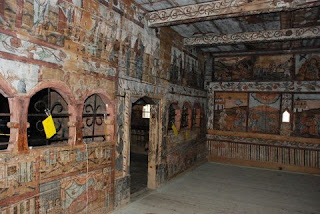




Blue sky greeted us this morning and the views were much cleared as we retraced route to 15 kilometres north of Vatra Dornei where we took a road north towards Sighetu Marmatiei. We were now following the river Bistrita again and we soon came to the village of Ciocanesti where there were many beautifully painted houses. There were also some lovely B&B places here, even one offering places for tents and motorhomes and, on another occasion, it would be a lovely place to stay and investigate the village further. We saw more painted houses after this but not the number that there were in Ciocanesti.
The road surface deteriorated and I discovered that badly patched asphalt is almost as bad as patched concrete. However badly patched asphalt is better than potholes with no patching and that came next. We had many kilometres of this very poor road with no villages, only mountains, the river and forest. The forest was the main source of employment here with much evidence of tree felling. We saw rafts of tree trunks stuck in the shallows at the edge of the river - they obviously still use the river in the Spring to transport the logs. At this time of the year there is insufficient depth of water for this and huge timber lorries pulled their massive loads up the hill – probably the cause of the massive number of potholes. We encountered a few of these but the road was so quiet that it was easy to pass them. We followed the river until, climbing up above it, we saw it move off west to its source just a few kilometres further into the mountains. Meanwhile we climbed the short distance to the pass where, despite the fact that there are only two alpine cabins (bars and restaurants), a few goats and alpine cows, they are building a huge church. I could be cynical and say that the money would be better spent on the road. We were surprised to see that quite a few other people had made it to the pass, including two coaches. We watched the young owner of an old car syphoning cooking oil from a plastic container into the fuel tank. This might have been because we were a long way from any fuel stations, but it is more likely to be because of the difference in price of cooking oil and petrol.
As we started to descend, deep valleys appeared below us as did the deep potholes in the road. We stopped in a small lay-by in order to admire the view and came across one of the many beekeepers that we have seen in the mountains. Most, like this one, have portable beehives in the form of brightly painted trailers, much smaller than those that we saw in the Danube Delta. I suspect that the trailers are left in their pitch for most of the year, only being removed for Winter. This is unlike the Danube Delta beehives that are moved around to find suitable crops.
The last part of the journey was on flatter land with much improved roads. The ethnographic experiences continued – today we saw ladies sat on benches outside their houses spinning wool using equipment that I have only ever seen in museums. It really is like going back in time over 100 years, the only things that spoil the effect being the vehicles on the road (and Henrietta is one of them) and mobile phones. It is really incongruous to see a man standing with his scythe resting on his shoulder, surrounded by a field of cut grass whilst he talks into his mobile phone - “Get the dinner ready darling, I will be back with the horse and cart shortly”.
We had read that there is an international folk music festival in Vadu Izei (just south of Sighetu Marmatiei) in mid July each year but searches on the Internet only showed reports of previous years events with no mention of dates for this year. The campsite owners in Bran had even tried to phone a regional tourist office for us but we still couldn't find any details. We arrived there hoping to see evidence of the festival but it was very quiet and there were no posters or banners advertising it. There was also a distinct lack of campsites there and in the large town of Sighetu Marmatiei (the most northerly town in Romania, just 2km from the Ukranian border) so we drove on a further 10km to Sapanta where our old guidebook said there was a campsite. It wasn't well signposted but, after a brief search, we found 'Camping Poieni' – very small but plenty of space for us. We parked up, hooked up to electricity in the barn and watched the alpine cows, bells jingling, wandering down the lane to the farm for milking.
Surprisingly for such a small campsite, it had a good bar and restaurant (called Casa Ana) and, after the regulation thunderstorm and torrential rain had subsided we made our way there. I had the local speciality of stuffed cabbage leaves, which was very good.
Photos: Inspecting the bees; One of the many painted houses in Ciocanesti with an excellent example of an elaborately decorated, enclosed well; The tall and very slim church in Ciocanesti; A wooden church at or near Salistea de Sus; The interior of the locked church, probably about to be restored.
No comments:
Post a Comment